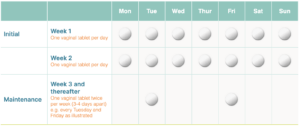Gina is indicated for the treatment of vaginal atrophy (VA) due to oestrogen deficiency in postmenopausal women aged 50 and above who have not had a period for at least one year.
Gina is the only product available without a prescription that effectively treats the cause of postmenopausal vaginal dryness. It acts to relieve symptoms of VA including:
Vaginal dryness | Itching | Burning | Soreness | Discomfort during sex
How Does Gina Work?
How Often to Use Gina
Gina is a vaginal tablet that comes with a single-use applicator, already loaded and ready to use. Each pack of Gina contains 24 of these preloaded applicators. You can start your treatment on any day that works best for you.
INITIAL DOSE: 1 vaginal tablet daily for 2 weeks, then follow maintenance dose.
MAINTENANCE DOSE: 1 vaginal tablet twice a week, leaving 3 or 4 days between each dose.

What happens if I miss a dose?
What side effects are there?
Commonly reported side effects include:
• Headache
• Abdominal pain
• Vaginal bleeding, discharge or discomfort
View Menopause Treatments
Sources



